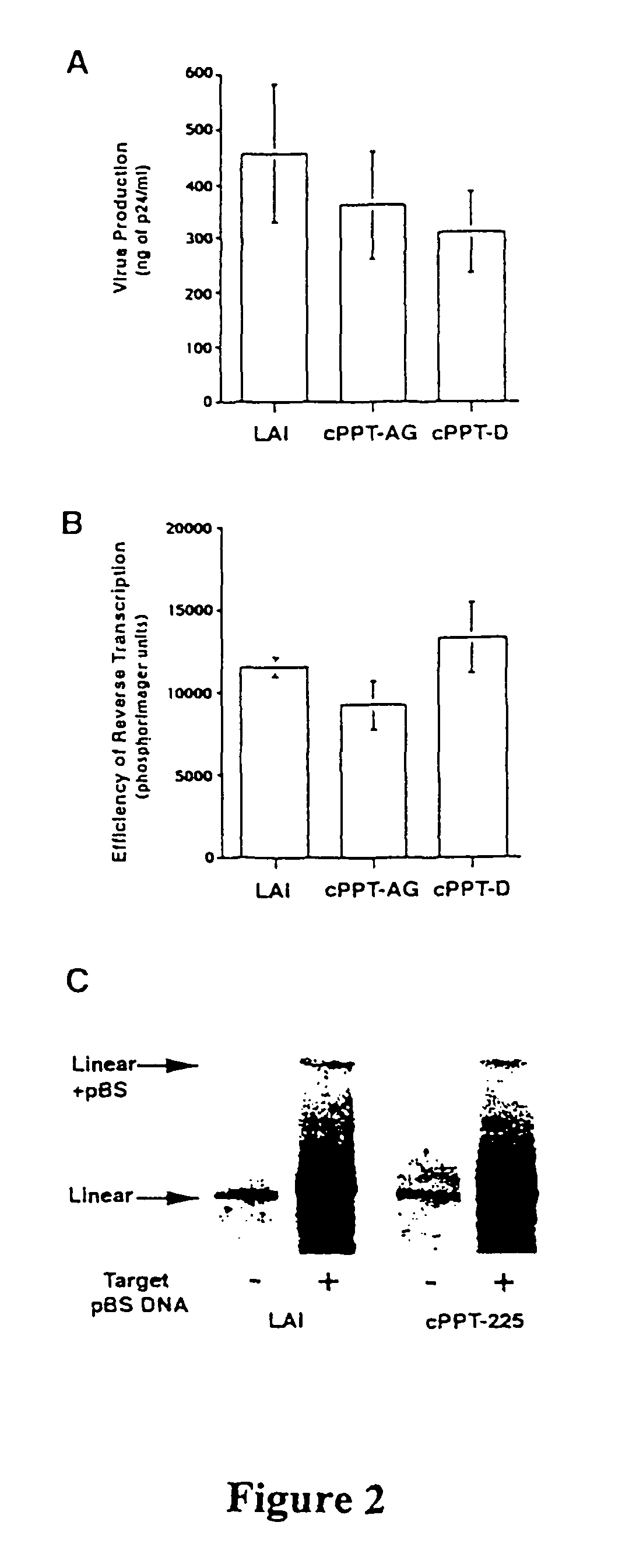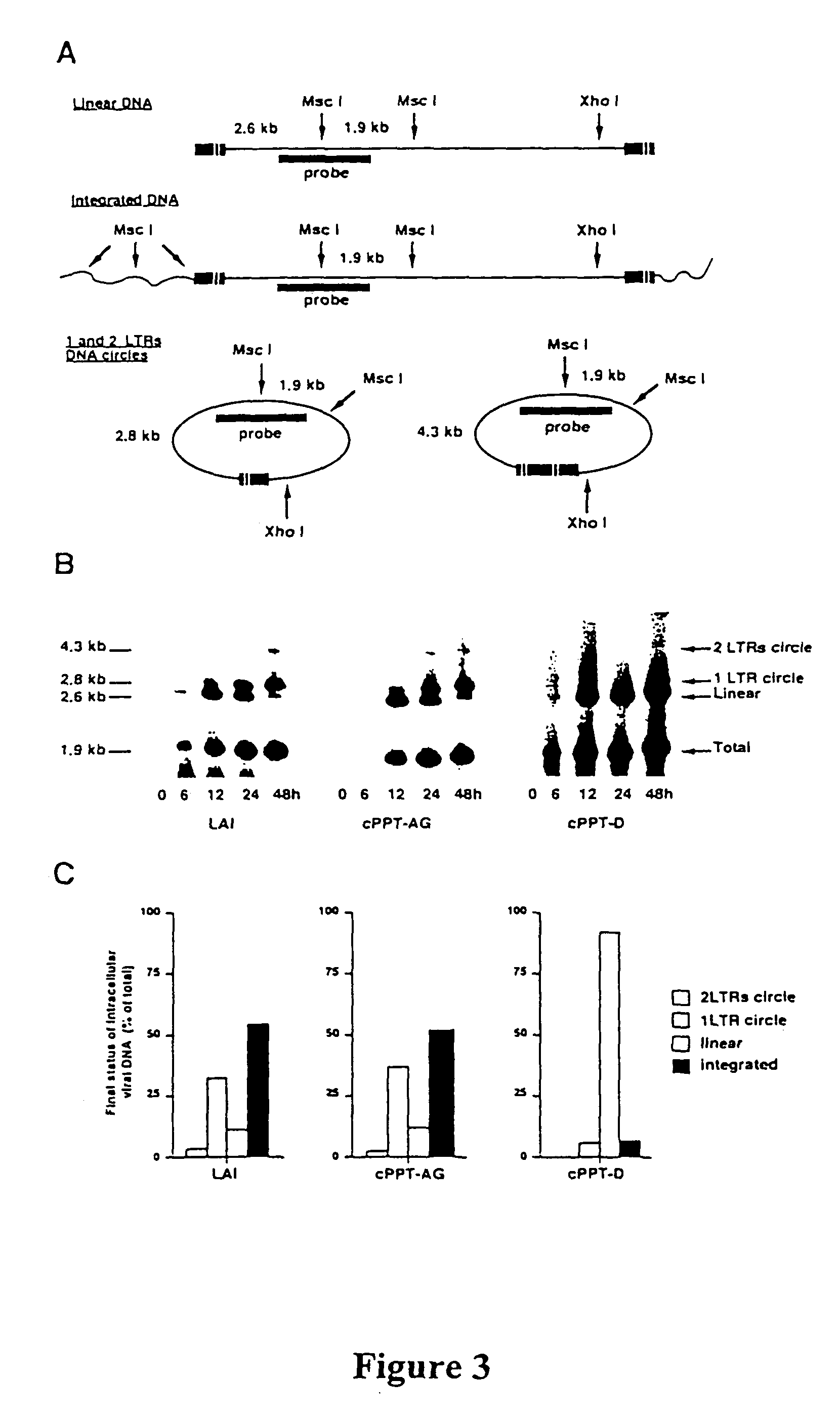Lentiviral triplex DNA, and vectors and recombinant cells containing lentiviral triplex DNA
a technology of lentiviral triplex and dna, applied in the field of biotechnology, can solve the problems of cytokine stimulation, proliferation, differentiation, and loss of potentialities of hsc during the transduction process, and achieve the effect of high-efficiency transfer of nucleic acids
- Summary
- Abstract
- Description
- Claims
- Application Information
AI Technical Summary
Benefits of technology
Problems solved by technology
Method used
Image
Examples
example 1
Experimental Procedures
Cells
[0084]MT4 cells are HTLV-1 transformed human CD4+ T cells that allow acute cytopathic HIV-1 infection (Harada et al., 1985). H9 cells are less permissive to HIV but allow chronic production after infection. MT4 and H9 cells were maintained in RPMI 1640 medium supplemented with 10% fetal calf serum (FCS). Peripheral blood lymphocytes (PBLs) were obtained from healthy donors, stimulated with 1 μg / ml of phytohemagglutinin (Wellcome), and maintained in the presence of Interleukin-2 (10% lymphocult; Biotest Diagnostics). 293T cells were grown in DMEM medium supplemented with 10% FCS. P4 indicator cells are HIV infectible HeLa CD4+ cells carrying the LacZ gene under the control of the HIV-1 LTR (Charneau et al., 1994). P4 cells are grown in DMEM medium supplemented with 10% FCS and 500 μg / ml of G418.
Collection and Fractionation of Cells.
[0085]Cord Blood samples were collected with the informed consent of the mothers. CD34+ cells were purified as previously desc...
example 2
Central Initiation of Reverse Transcription is an Essential Step of the HIV-1 Replicative Cycle
[0117]In a previous work, we showed that conservative mutations in the cPPT and CTS sequences severely impaired virus replication (Charneau et al., 1992; Hungnes et al., 1992). A central initiation mutant virus (cPPT-225) and a termination mutant virus (CTS) showed respectively four fold and ten fold decreased infectivity in one round titration experiments. In order to inactivate the function of the cPPT, semi-conservative mutations were introduced in the overlapping integrase coding region. In the mutant virus cPPT-D, the lysine to arginine change at position 188 allowed the introduction of a total of 10 mutations into the 19 nucleotide sequence of the PPT primer (FIG. 1A) (Huber and Richardson, 1990). The effect of this amino acid change on virus replication was checked by construction of the control cPPT-AG mutant virus, in which a single mutation from purine to purine, respecting the p...
example 3
Virus Production is Not Affected by Mutations in cPPT
[0121]We checked that the different mutations introduced into the cPPT-AG and cPPT-D plasmid proviruses did not affect the late steps of the replicative cycle. Virus production was quantified, according to the P24 content of the supernatants, after transient transfections of HeLa cells by proviral plasmids. The production of the cPPT mutant viruses was found not to be significantly different from that of the wild type virus (FIG. 2A). Hence the mutation K188R does not affect the late phase of HIV-1 replication. Therefore, the defective step involved in the phenotype of the cPPT-D mutant virus must precede the expression of viral DNA and belong to the early phase of the HIV replicative cycle.
PUM
| Property | Measurement | Unit |
|---|---|---|
| diameter | aaaaa | aaaaa |
| concentration | aaaaa | aaaaa |
| concentration | aaaaa | aaaaa |
Abstract
Description
Claims
Application Information
 Login to View More
Login to View More - R&D Engineer
- R&D Manager
- IP Professional
- Industry Leading Data Capabilities
- Powerful AI technology
- Patent DNA Extraction
Browse by: Latest US Patents, China's latest patents, Technical Efficacy Thesaurus, Application Domain, Technology Topic, Popular Technical Reports.
© 2024 PatSnap. All rights reserved.Legal|Privacy policy|Modern Slavery Act Transparency Statement|Sitemap|About US| Contact US: help@patsnap.com










